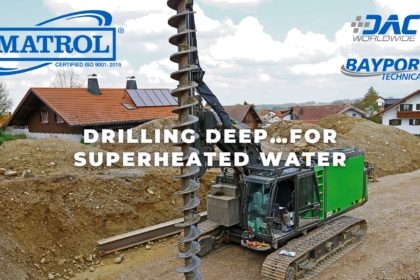
If someone asked you what the opposite of a fossil fuel is, what would you say? Some might say solar power, while others would point to wind. Either answer could be correct, since any form of renewable energy could be considered the opposite of our finite supply of fossil fuels like oil and gas.
Wouldn’t it be ironic then if a form of renewable energy ended up being the savior of a large chunk of oil and gas jobs? That seemingly impossible scenario is playing out right now in areas of Texas and New Mexico thanks to a resurgence of interest in geothermal energy.
In a recent article on The Hill website by Saul Elbein, the author notes that, despite the last several years representing “the height of the largest oil and gas boom in American history,” “the expansion in production has come with a sharp and protracted decline in both the number of rigs and rig workers…due to the pace of drilling and the declining need for workers amid the rise of high-tech forms of extraction.”
That’s right. Many of today’s oil and gas workers have literally drilled themselves out of a job. However, some are now learning they could be using “some of the same skills and technology used to extract fossil fuels for the production of renewable energy.”
The Permian Basin in western Texas and eastern New Mexico has recently been “the heart of the oil and gas boom.” A growing number of companies are now looking at the same area as a source of renewable energy. As Elbein points out, “beneath its bones lies another resource central to the new movement in the region’s energy industry: heat that…companies…hope to tap for clean power.”
Although “geothermal energy has long been a niche one in the renewables sector because of its reliance on a very particular set of underground conditions: accessible, superheated pools of underground water, like those found beneath pockets of California, the Pacific’s Ring of Fire and the nation of Iceland,” a growing number of companies are now “seeking to develop methods that could be used to generate geothermal power virtually anywhere in the country.”
Developing support for geothermal in the heart of oil and gas country might seem like a challenge, but investors have found proponents who see geothermal as additional security for the increasingly burdened power grid. As population, artificial intelligence (AI) data centers, and cryptocurrency mining facilities grow in number and size, geothermal sites represent the potential for “secure power sources not subject to extreme weather or alleged market manipulation by oil and gas companies.”
Perhaps more importantly for the oil and gas workforce, proponents “see geothermal as a long-term life raft for oil and gas workers increasingly idled as layoffs beset the industry.” Geothermal companies are using “oil and gas-based technologies to create the precise underground conditions needed to tap the heat beneath the region’s surface — either for electricity, industrial power or heating and cooling.”
Fortunately for oil and gas workers, geothermal has the opposite problem as traditional oil and gas, which has too many staff and rigs compared to available work. Geothermal companies have more available jobs than they have staff to support them. For oil and gas workers, the future appears to be one in which they may need a hybrid of traditional oil and gas skills mixed with geothermal expertise.
For Texas, New Mexico, and any other states navigating the transition from fossil fuels to alternative energy sources, Amatrol, along with its sister companies, DAC Worldwide and Bayport Technical, offer a wide variety of training tools and systems to teach workers the skills they need to succeed.
For example, both DAC Worldwide and Bayport Technical manufacture oil and gas training tools and systems that teach hands-on technical skills with real industrial equipment they’ll encounter on the job. Here are a couple of samples of the types of training aids these companies produce:
- DAC Worldwide’s Extended Wellhead Assembly Cutaway (295-795E) depicts the complete assembly of components used in creating a wellhead, which are used in oil & gas production operations. The full-size, fully detailed example of a high-pressure wellhead assembly gives learners a first-hand view into a component that is found in oilfield applications worldwide.
- Bayport Technical’s Cooling Tower Working Demonstrator (142-CT2) is a scaled, acrylic replica of a forced draft cooling tower used in oil refineries and petrochemical plants. This working demonstrator allows a full view of how water is filtered through the tower to cool it off and then return it the factory. This tabletop system includes a water basin and distribution system, heater assembly, pump, fan, splash bars, air intake louvers, draft eliminators, and temperature gauges.
When it comes to teaching the geothermal skills workers will need, Amatrol’s geothermal training system combines in-depth curriculum with real industrial equipment:
- Amatrol’s 950-GEO2D Geothermal Troubleshooting Learning System with Desuperheater uses an exposed component layout so that learners can see each component’s role in a geothermal system. Learners can easily observe, monitor, and test each component mounted and labeled on a vertical panel. Sight glasses installed in the 950-GEO2D allow the learner to see the refrigerant’s changing state as it passes through the system. Amatrol also includes pressure and temperature gauges at key points to show the system’s performance at a glance. Additionally, the system includes a custom designed, temperature-controlled ground simulator so the system can run continuously.
Reach out to an expert training consultant with Amatrol today to get started on the path to training the next generation of workers!



